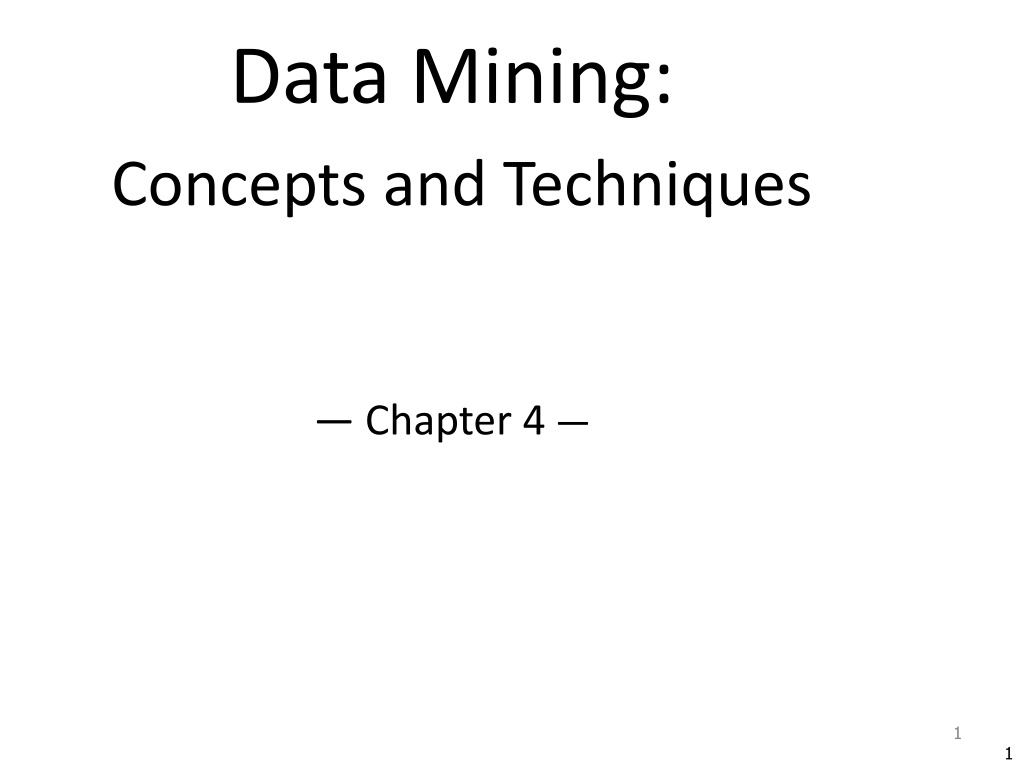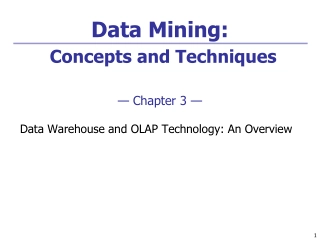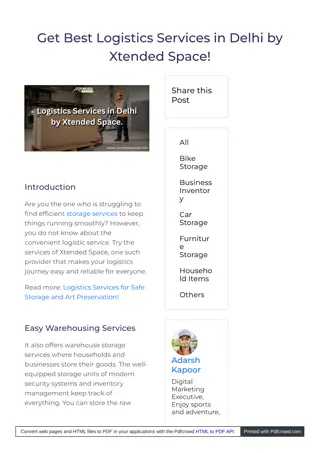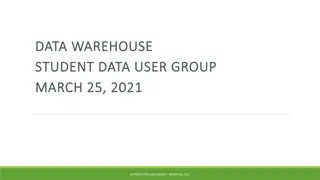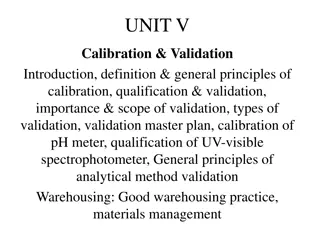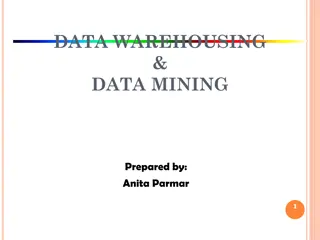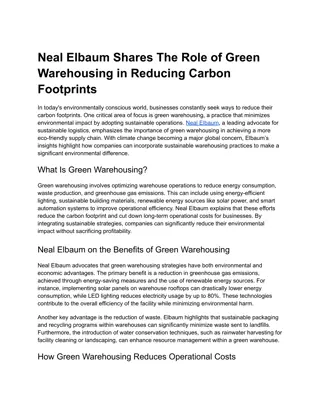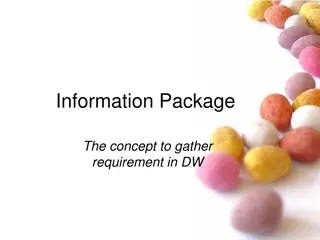Data Warehousing Concepts and Techniques
A data warehouse is a decision support database separate from operational databases, providing consolidated, historical data for analysis. It is subject-oriented, integrated, time-variant, and nonvolatile, supporting management decision-making. Key aspects include subject-oriented organization, data integration from heterogeneous sources, a long time horizon, and separation from operational data environments.
Uploaded on Sep 16, 2024 | 0 Views
Download Presentation

Please find below an Image/Link to download the presentation.
The content on the website is provided AS IS for your information and personal use only. It may not be sold, licensed, or shared on other websites without obtaining consent from the author.If you encounter any issues during the download, it is possible that the publisher has removed the file from their server.
You are allowed to download the files provided on this website for personal or commercial use, subject to the condition that they are used lawfully. All files are the property of their respective owners.
The content on the website is provided AS IS for your information and personal use only. It may not be sold, licensed, or shared on other websites without obtaining consent from the author.
E N D
Presentation Transcript
Data Mining: Concepts and Techniques Chapter 4 1 1
Chapter 4: Data Warehousing and On-line Analytical Processing Data Warehouse: Basic Concepts Data Warehouse Modeling: Data Cube and OLAP Data Warehouse Design and Usage Data Warehouse Implementation Data Generalization by Attribute-Oriented Induction Summary 2
What is a Data Warehouse? Defined in many different ways, but not rigorously. A decision support database that is maintained separately from the organization s operational database Support information processing by providing a solid platform of consolidated, historical data for analysis. A data warehouse is a subject-oriented, integrated, time-variant, and nonvolatile collection of data in support of management s decision-making process. W. H. Inmon Data warehousing: The process of constructing and using data warehouses 3
Data WarehouseSubject-Oriented Organized around major subjects, such as customer, product, sales Focusing on the modeling and analysis of data for decision makers, not on daily operations or transaction processing Provide a simple and concise view around particular subject issues by excluding data that are not useful in the decision support process 4
Data WarehouseIntegrated Constructed by integrating multiple, heterogeneous data sources relational databases, flat files, on-line transaction records Data cleaning and data integration techniques are applied. Ensure consistency in naming conventions, encoding structures, attribute measures, etc. among different data sources E.g., Hotel price: currency, tax, breakfast covered, etc. When data is moved to the warehouse, it is converted. 5
Data WarehouseTime Variant The time horizon for the data warehouse is significantly longer than that of operational systems Operational database: current value data Data warehouse data: provide information from a historical perspective (e.g., past 5-10 years) Every key structure in the data warehouse Contains an element of time, explicitly or implicitly But the key of operational data may or may not contain time element 6
Data WarehouseNonvolatile A physically separate store of data transformed from the operational environment Operational update of data does not occur in the data warehouse environment Does not require transaction processing, recovery, and concurrency control mechanisms Requires only two operations in data accessing: initial loading of data and access of data 7
OLTP vs. OLAP users function DB design data OLTP clerk, IT professional day to day operations application-oriented current, up-to-date detailed, flat relational isolated repetitive read/write index/hash on prim. key short, simple transaction tens thousands 100MB-GB transaction throughput OLAP knowledge worker decision support subject-oriented historical, summarized, multidimensional integrated, consolidated ad-hoc lots of scans usage access unit of work # records accessed #users DB size metric complex query millions hundreds 100GB-TB query throughput, response 8
Why a Separate Data Warehouse? High performance for both systems DBMS tuned for OLTP: access methods, indexing, concurrency control, recovery Warehouse tuned for OLAP: complex OLAP queries, multidimensional view, consolidation Different functions and different data: missing data: Decision support requires historical data which operational DBs do not typically maintain data consolidation: DS requires consolidation (aggregation, summarization) of data from heterogeneous sources data quality: different sources typically use inconsistent data representations, codes and formats which have to be reconciled Note: There are more and more systems which perform OLAP analysis directly on relational databases 9
Data Warehouse: A Multi-Tiered Architecture Monitor & Integrator OLAP Server Metadata Other sources Analysis Query Reports Data mining Operational DBs Extract Transform Load Refresh Serve Data Warehouse Data Marts Data Sources Data Storage OLAP Engine Front-End Tools 10
Three Data Warehouse Models Enterprise warehouse collects all of the information about subjects spanning the entire organization Data Mart a subset of corporate-wide data that is of value to a specific groups of users. Its scope is confined to specific, selected groups, such as marketing data mart Independent vs. dependent (directly from warehouse) data mart Virtual warehouse A set of views over operational databases Only some of the possible summary views may be materialized 11
Extraction, Transformation, and Loading (ETL) Data extraction get data from multiple, heterogeneous, and external sources Data cleaning detect errors in the data and rectify them when possible Data transformation convert data from legacy or host format to warehouse format Load sort, summarize, consolidate, compute views, check integrity, and build indicies and partitions Refresh propagate the updates from the data sources to the warehouse 12
Metadata Repository Meta data is the data defining warehouse objects. It stores: Description of the structure of the data warehouse schema, view, dimensions, hierarchies, derived data defn, data mart locations and contents Operational meta-data data lineage (history of migrated data and transformation path), currency of data (active, archived, or purged), monitoring information (warehouse usage statistics, error reports, audit trails) The algorithms used for summarization The mapping from operational environment to the data warehouse Data related to system performance warehouse schema, view and derived data definitions Business data business terms and definitions, ownership of data, charging policies 13
Chapter 4: Data Warehousing and On-line Analytical Processing Data Warehouse: Basic Concepts Data Warehouse Modeling: Data Cube and OLAP Data Warehouse Design and Usage Data Warehouse Implementation Data Generalization by Attribute-Oriented Induction Summary 14
From Tables and Spreadsheets to Data Cubes A data warehouse is based on a multidimensional data model which views data in the form of a data cube A data cube, such as sales, allows data to be modeled and viewed in multiple dimensions Dimension tables, such as item (item_name, brand, type), or time(day, week, month, quarter, year) Fact table contains measures (such as dollars_sold) and keys to each of the related dimension tables In data warehousing literature, an n-D base cube is called a base cuboid. The top most 0-D cuboid, which holds the highest-level of summarization, is called the apex cuboid. The lattice of cuboids forms a data cube. 15
Cube: A Lattice of Cuboids all 0-D (apex) cuboid time item location supplier 1-D cuboids time,location item,location location,supplier 2-D cuboids time,item time,supplier item,supplier time,location,supplier 3-D cuboids time,item,location item,location,supplier time,item,supplier 4-D (base) cuboid time, item, location, supplier 16
Conceptual Modeling of Data Warehouses Modeling data warehouses: dimensions & measures Star schema: A fact table in the middle connected to a set of dimension tables Snowflake schema: A refinement of star schema where some dimensional hierarchy is normalized into a set of smaller dimension tables, forming a shape similar to snowflake Fact constellations: Multiple fact tables share dimension tables, viewed as a collection of stars, therefore called galaxy schema or fact constellation 17
Example of Star Schema time item time_key day day_of_the_week month quarter year item_key item_name brand type supplier_type Sales Fact Table time_key item_key branch_key location branch location_key location_key street city state_or_province country branch_key branch_name branch_type units_sold dollars_sold avg_sales Measures 18
Example of Snowflake Schema time item time_key day day_of_the_week month quarter year item_key item_name brand type supplier_key supplier Sales Fact Table supplier_key supplier_type time_key item_key branch_key location branch location_key location_key street city_key branch_key branch_name branch_type units_sold city dollars_sold city_key city state_or_province country avg_sales Measures 19
Example of Fact Constellation time item Shipping Fact Table time_key day day_of_the_week month quarter year item_key item_name brand type supplier_type time_key Sales Fact Table item_key time_key shipper_key item_key from_location branch_key to_location branch location_key location branch_key branch_name branch_type dollars_cost location_key street city province_or_state country units_sold units_shipped dollars_sold avg_sales shipper Measures shipper_key shipper_name location_key shipper_type 20
A Concept Hierarchy: Dimension (location) all all Europe ... North_America region Germany ... Spain Canada ... Mexico country Vancouver ... city Frankfurt ... Toronto L. Chan ... M. Wind office 21
Data Cube Measures: Three Categories Distributive: if the result derived by applying the function to n aggregate values is the same as that derived by applying the function on all the data without partitioning E.g., count(), sum(), min(), max() Algebraic: if it can be computed by an algebraic function with M arguments (where M is a bounded integer), each of which is obtained by applying a distributive aggregate function E.g., avg(), min_N(), standard_deviation() Holistic: if there is no constant bound on the storage size needed to describe a subaggregate. E.g., median(), mode(), rank() 22
View of Warehouses and Hierarchies Specification of hierarchies Schema hierarchy day < {month < quarter; week} < year Set_grouping hierarchy {1..10} < inexpensive 23
Multidimensional Data Sales volume as a function of product, month, and region Dimensions: Product, Location, Time Hierarchical summarization paths Industry Region Year Category Country Quarter Product Product City Month Week Office Day Month 24
A Sample Data Cube Total annual sales of TVs in U.S.A. Date 3Qtr 2Qtr 1Qtr sum 4Qtr TV U.S.A PC VCR Country sum Canada Mexico sum All, All, All 25
Cuboids Corresponding to the Cube all 0-D (apex) cuboid country product date 1-D cuboids product,date product,country date, country 2-D cuboids 3-D (base) cuboid product, date, country 26
Typical OLAP Operations Roll up (drill-up): summarize data by climbing up hierarchy or by dimension reduction Drill down (roll down): reverse of roll-up from higher level summary to lower level summary or detailed data, or introducing new dimensions Slice and dice: project and select Pivot (rotate): reorient the cube, visualization, 3D to series of 2D planes Other operations drill across: involving (across) more than one fact table drill through: through the bottom level of the cube to its back- end relational tables (using SQL) 27
Fig. 3.10 Typical OLAP Operations 28
A Star-Net Query Model Customer Orders Shipping Method Customer CONTRACTS AIR-EXPRESS ORDER TRUCK PRODUCT LINE Time Product ANNUALY QTRLY DAILY PRODUCT ITEM PRODUCT GROUP CITY SALES PERSON COUNTRY DISTRICT REGION DIVISION Each circle is called a footprint Location Promotion Organization 29
Browsing a Data Cube Visualization OLAP capabilities Interactive manipulation 30
Chapter 4: Data Warehousing and On-line Analytical Processing Data Warehouse: Basic Concepts Data Warehouse Modeling: Data Cube and OLAP Data Warehouse Design and Usage Data Warehouse Implementation Data Generalization by Attribute-Oriented Induction Summary 31
Design of Data Warehouse: A Business Analysis Framework Four views regarding the design of a data warehouse Top-down view allows selection of the relevant information necessary for the data warehouse Data source view exposes the information being captured, stored, and managed by operational systems Data warehouse view consists of fact tables and dimension tables Business query view sees the perspectives of data in the warehouse from the view of end-user 32
Data Warehouse Design Process Top-down, bottom-up approaches or a combination of both Top-down: Starts with overall design and planning (mature) Bottom-up: Starts with experiments and prototypes (rapid) From software engineering point of view Waterfall: structured and systematic analysis at each step before proceeding to the next Spiral: rapid generation of increasingly functional systems, short turn around time, quick turn around Typical data warehouse design process Choose a business process to model, e.g., orders, invoices, etc. Choose the grain (atomic level of data) of the business process Choose the dimensions that will apply to each fact table record Choose the measure that will populate each fact table record 33
Data Warehouse Development: A Recommended Approach Multi-Tier Data Warehouse Distributed Data Marts Enterprise Data Warehouse Data Mart Data Mart Model refinement Model refinement Define a high-level corporate data model 34
Data Warehouse Usage Three kinds of data warehouse applications Information processing supports querying, basic statistical analysis, and reporting using crosstabs, tables, charts and graphs Analytical processing multidimensional analysis of data warehouse data supports basic OLAP operations, slice-dice, drilling, pivoting Data mining knowledge discovery from hidden patterns supports associations, constructing analytical models, performing classification and prediction, and presenting the mining results using visualization tools 35
From On-Line Analytical Processing (OLAP) to On Line Analytical Mining (OLAM) Why online analytical mining? High quality of data in data warehouses DW contains integrated, consistent, cleaned data Available information processing structure surrounding data warehouses ODBC, OLEDB, Web accessing, service facilities, reporting and OLAP tools OLAP-based exploratory data analysis Mining with drilling, dicing, pivoting, etc. On-line selection of data mining functions Integration and swapping of multiple mining functions, algorithms, and tasks 36
Chapter 4: Data Warehousing and On-line Analytical Processing Data Warehouse: Basic Concepts Data Warehouse Modeling: Data Cube and OLAP Data Warehouse Design and Usage Data Warehouse Implementation Data Generalization by Attribute-Oriented Induction Summary 37
Efficient Data Cube Computation Data cube can be viewed as a lattice of cuboids The bottom-most cuboid is the base cuboid The top-most cuboid (apex) contains only one cell How many cuboids in an n-dimensional cube with L levels? n i L T = ) 1 + 1( = i Materialization of data cube Materialize every (cuboid) (full materialization), none (no materialization), or some (partial materialization) Selection of which cuboids to materialize Based on size, sharing, access frequency, etc. 38
The Compute Cube Operator Cube definition and computation in DMQL define cube sales [item, city, year]: sum (sales_in_dollars) compute cube sales Transform it into a SQL-like language (with a new operator cube by, introduced by Gray et al. 96) () SELECT item, city, year, SUM (amount) (city) (item) (year) FROM SALES CUBE BY item, city, year Need compute the following Group-Bys (date, product, customer), (date,product),(date, customer), (product, customer), (date), (product), (customer) () (city, item) (city, year) (item, year) (city, item, year) 39
Indexing OLAP Data: Bitmap Index Index on a particular column Each value in the column has a bit vector: bit-op is fast The length of the bit vector: # of records in the base table The i-th bit is set if the i-th row of the base table has the value for the indexed column not suitable for high cardinality domains A recent bit compression technique, Word-Aligned Hybrid (WAH), makes it work for high cardinality domain as well [Wu, et al. TODS 06] Base table Index on Region Index on Type Cust Region Type C1 Asia C2 Europe Dealer C3 Asia C4 America Retail C5 Europe Dealer RecIDAsia Europe America 1 1 2 0 3 1 4 0 5 0 RecID Retail Dealer 1 1 2 0 3 0 4 1 5 0 Retail 0 1 0 0 1 0 0 0 1 0 0 1 1 0 1 Dealer 40
Indexing OLAP Data: Join Indices Join index: JI(R-id, S-id) where R (R-id, ) S (S-id, ) Traditional indices map the values to a list of record ids It materializes relational join in JI file and speeds up relational join In data warehouses, join index relates the values of the dimensions of a start schema to rows in the fact table. E.g. fact table: Sales and two dimensions city and product A join index on city maintains for each distinct city a list of R-IDs of the tuples recording the Sales in the city Join indices can span multiple dimensions 41
Efficient Processing OLAP Queries Determine which operations should be performed on the available cuboids Transform drill, roll, etc. into corresponding SQL and/or OLAP operations, e.g., dice = selection + projection Determine which materialized cuboid(s) should be selected for OLAP op. Let the query to be processed be on {brand, province_or_state} with the condition year = 2004 , and there are 4 materialized cuboids available: 1) {year, item_name, city} 2) {year, brand, country} 3) {year, brand, province_or_state} 4) {item_name, province_or_state} where year = 2004 Which should be selected to process the query? Explore indexing structures and compressed vs. dense array structs in MOLAP 42
OLAP Server Architectures Relational OLAP (ROLAP) Use relational or extended-relational DBMS to store and manage warehouse data and OLAP middle ware Include optimization of DBMS backend, implementation of aggregation navigation logic, and additional tools and services Greater scalability Multidimensional OLAP (MOLAP) Sparse array-based multidimensional storage engine Fast indexing to pre-computed summarized data Hybrid OLAP (HOLAP) (e.g., Microsoft SQLServer) Flexibility, e.g., low level: relational, high-level: array Specialized SQL servers (e.g., Redbricks) Specialized support for SQL queries over star/snowflake schemas 43
Chapter 4: Data Warehousing and On-line Analytical Processing Data Warehouse: Basic Concepts Data Warehouse Modeling: Data Cube and OLAP Data Warehouse Design and Usage Data Warehouse Implementation Data Generalization by Attribute-Oriented Induction Summary 44
Attribute-Oriented Induction Proposed in 1989 (KDD 89 workshop) Not confined to categorical data nor particular measures How it is done? Collect the task-relevant data (initial relation) using a relational database query Perform generalization by attribute removal or attribute generalization Apply aggregation by merging identical, generalized tuples and accumulating their respective counts Interaction with users for knowledge presentation 45
Attribute-Oriented Induction: An Example Example: Describe general characteristics of graduate students in the University database Step 1. Fetch relevant set of data using an SQL statement, e.g., Select * (i.e., name, gender, major, birth_place, birth_date, residence, phone#, gpa) from student where student_status in { Msc , MBA , PhD } Step 2. Perform attribute-oriented induction Step 3. Present results in generalized relation, cross-tab, or rule forms 46
Class Characterization: An Example Name Jim Woodman Scott Lachance Laura Lee Gender M Major CS Birth-Place Vancouver,BC, Canada Montreal, Que, Canada Seattle, WA, USA Birth_date 8-12-76 Residence 3511 Main St., Richmond 345 1st Ave., Richmond 125 Austin Ave., Burnaby City Phone # 687-4598 GPA 3.67 Initial Relation M CS 28-7-75 253-9106 3.70 F Physics 25-8-70 420-5232 3.83 Country Age range Removed Excl, VG,.. Removed Retained Sci,Eng, Bus Gender Major M F Birth_region Canada Foreign Age_range 20-25 25-30 Residence Richmond Burnaby GPA Very-good Excellent Count 16 22 Prime Generalized Relation Science Science Birth_Region Canada Foreign Total Gender M F 16 10 14 22 30 32 Total 26 36 62 47
Basic Principles of Attribute-Oriented Induction Data focusing: task-relevant data, including dimensions, and the result is the initial relation Attribute-removal: remove attribute A if there is a large set of distinct values for A but (1) there is no generalization operator on A, or (2) A s higher level concepts are expressed in terms of other attributes Attribute-generalization: If there is a large set of distinct values for A, and there exists a set of generalization operators on A, then select an operator and generalize A Attribute-threshold control: typical 2-8, specified/default Generalized relation threshold control: control the final relation/rule size 48
Attribute-Oriented Induction: Basic Algorithm InitialRel: Query processing of task-relevant data, deriving the initial relation. PreGen: Based on the analysis of the number of distinct values in each attribute, determine generalization plan for each attribute: removal? or how high to generalize? PrimeGen: Based on the PreGen plan, perform generalization to the right level to derive a prime generalized relation , accumulating the counts. Presentation: User interaction: (1) adjust levels by drilling, (2) pivoting, (3) mapping into rules, cross tabs, visualization presentations. 49
Presentation of Generalized Results Generalized relation: Relations where some or all attributes are generalized, with counts or other aggregation values accumulated. Cross tabulation: Mapping results into cross tabulation form (similar to contingency tables). Visualization techniques: Pie charts, bar charts, curves, cubes, and other visual forms. Quantitative characteristic rules: Mapping generalized result into characteristic rules with quantitative information associated with it, e.g., ( ) ( ) grad x male x = = _ ( ) " [ " : 53 %] _ ( ) " [ " : 47 %] birth region x Canada t birth region x foreign t . 50
